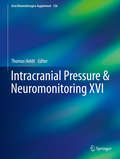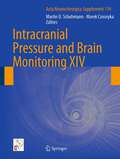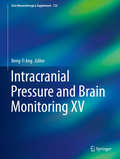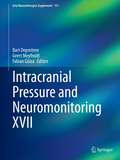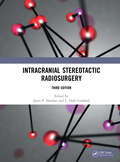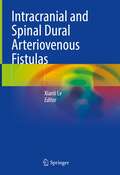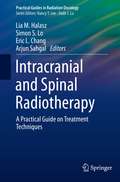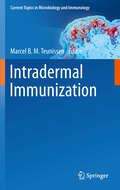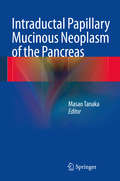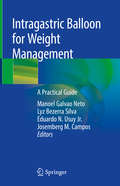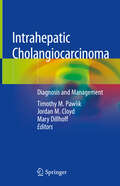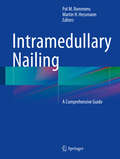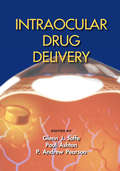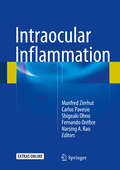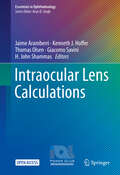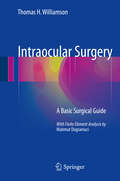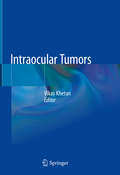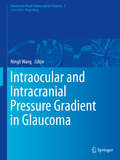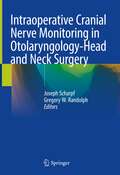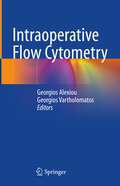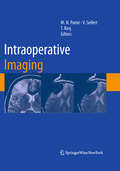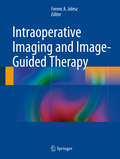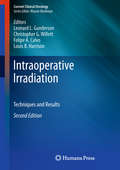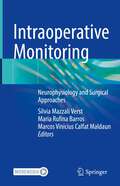- Table View
- List View
Intracranial Pressure & Neuromonitoring XVI (Acta Neurochirurgica Supplement #126)
by Thomas HeldtThis book introduces the latest advances relating to the pathophysiology, biophysics, monitoring and treatment of traumatic brain injury, hydrocephalus, and stroke presented at the 16th International Conference on Intracranial Pressure and Neuromonitoring (the "ICP Conference"), held in Cambridge, Massachusetts, in June 2016 in conjunction with the 6th Annual Meeting of the Cerebral Autoregulation Research Network. Additionally, the conference held special sessions on neurocritical care informatics and cerebrovascular autoregulation. The peer-reviewed papers included were written by leading experts in neurosurgery, neurointensive care, anesthesiology, physiology, clinical engineering, clinical informatics and mathematics who have made important contributions in this translational area of research, and their focus ranges from the latest research findings and developments to clinical trials and experimental studies. The book continues the proud tradition of publishing key work from the ICP Conferences and is a must-read for anyone wishing to stay abreast of recent advances in the field.
Intracranial Pressure and Brain Monitoring XIV
by Marek Czosnyka Martin U. SchuhmannNearly 80 short papers originating from the 14th International Symposium on Intracranial Pressure and Brain Monitoring held in Tuebingen, Germany, in September 2010 present experimental as well as clinical research data related to the naming topics of the conference. The papers have undergone a peer-reviewing and are organized in the following sections: methods of brain monitoring and data analysis, methods of invasive and non-invasive ICP assessment, the role of autoregulation, the role of tissue oxygenation and near-infrared spectroscopy, hydrocephalus/IIH imaging and diagnosis, management and therapy of hydrocephalus, management and therapy of traumatic brain injury, management and therapy of subarachnoid and intracranial hemorrhage, experimental approaches to acute brain disease. The book gives a good overview on the latest research developments in the field of ICP and related brain monitoring and on management and therapy of relevant acute brain diseases.
Intracranial Pressure and Brain Monitoring XV
by Beng-Ti AngThis volume showcases recent high-quality work relating to the pathophysiology, biophysics, monitoring, and treatment of traumatic brain injury and hydrocephalus that was presented at the 15th International Symposium on Intracranial Pressure and Brain Monitoring (ICP), held in Singapore in November 2013. The included papers derive from experts in neurointensive care, physiology, physics, engineering, and neurosurgery who have made important contributions in this translational area of research. All were selected from among oral and oral-poster presentations following a rigorous peer-review process involving the ICP Board members, and their focus ranges from the latest research findings and developments to clinical trials and experimental studies. This collection of papers from ICP 2013 continues the proud tradition of publishing key work from the ICP symposia and will be of interest for all who wish to stay abreast of recent advances in the field.
Intracranial Pressure and Neuromonitoring XVII (Acta Neurochirurgica Supplement #131)
by Bart Depreitere Geert Meyfroidt Fabian GüizaThis book gathers the proceedings of the 17th International Conference on Intracranial Pressure and Neuromonitoring, held in Leuven, Belgium in September 2019. It provides an overview of the current understanding, underlying research and future perspectives concerning pathophysiology, biophysics, monitoring and management in traumatic and non-traumatic acute brain injury, hydrocephalus and spinal cord injury, including cerebrovascular autoregulation impairment in neurological as well as non-neurological diseases. The peer-reviewed contributions were prepared by specialists in neurosurgery, neurointensive care and neuroanesthesiology, as well as prominent experts from the fields of physiology, clinical and biomedical engineering, mathematics and informatics. The book continues the time-honored tradition of publishing key presentations from the ICP Conferences in order to facilitate their dissemination within the clinical and research community.
Intracranial Stereotactic Radiosurgery
by Jason P. Sheehan L. Dade LunsfordIn this third edition of Intracranial Stereotactic Radiosurgery, Drs. Sheehan and Lunsford provide an updated assessment of the practice of stereotactic radiosurgery. Topics include benign and malignant tumors, cerebrovascular abnormalities, and functional disorders. Several new topics are now included and focus on immunotherapy, hypofractionation, and repeat radiosurgery. Each chapter contains key figures and tables to illustrate the critical concepts of the work. Contributors to the book represent many of the most prestigious stereotactic radiosurgery centers across the world. This book is comprised of 36 chapters and represents a comprehensive update to prior editions. It is intended to be a readable, credible, and accessible reference on stereotactic radiosurgery. Editors Jason Sheehan, MD, PhD, FACS, FAANS, is the Vice Chair and Harrison Distinguished Professor of Neurological Surgery at the University of Virginia (UVA). He also serves as the Neurosciences Service Line Director at UVA. Dr. Sheehan is the current chair of the American Association of Neurological Surgeons (AANS) and Congress of Neurological Surgeons (CNS) Section on Tumors. He serves as the Editor-In-Chief of the Journal of Neuro-Oncology. L. Dade Lunsford, MD, serves as the Lars Leksell Professor and Distinguished Professor at the Department of Neurological Surgery at the University of Pittsburgh. He is also director of the Center for Image-Guided Neurosurgery at the University of Pittsburgh Medical Center and an internationally recognized authority on stereotactic surgery, radiosurgery, and minimally invasive surgery. He has authored or coauthored more than 1,000 scientific reports and 16 books.
Intracranial and Spinal Dural Arteriovenous Fistulas
by Xianli LvThe book introduces techniques, devices, device structures and therapeutic in dural arteriovenous fistulas. During past 4 decades, neurovascular or endovasuclar surgery developed fast and provide effective and minimally invasive treatment of dural arteriovenous fistulas. The treatment of dural arteriovenous fistulas has also seen substantial evolution, increasing the number of dural arteriovenous fistulas that can be treated successfully with minimally invasive therapy. Authors introduces the great advances in the techniques, devices and treatment concepts, which shows striking therapeutic benefit for dural arteriovenous fistulas. In each technique, authors introduce methods, cases, result, discussion and conclusion. The CT scan, MR imaging, angiography and surgical figures are provided in each chapter. Attending physicians, fellows, residents, medical students will benefit from reading this text.
Intracranial and Spinal Radiotherapy: A Practical Guide on Treatment Techniques (Practical Guides in Radiation Oncology)
by Simon S. Lo Eric L. Chang Arjun Sahgal Lia M. HalaszThis book is a practical, up-to-date guide to the treatment of patients with brain and spinal tumors. Leading experts in the field explain treatment techniques in detail, highlighting key considerations in the use of external beam radiation therapy, intensity-modulated radiation therapy, particle therapy, radiosurgery, and stereotactic body radiation therapy. Specific recommendations are described for different tumor types, and helpful information provided on other important issues, such as the interaction of radiotherapy and systemic therapy and the avoidance of treatment complications. With the development of modern technology, highly conformal radiotherapy techniques have become more complicated, yet also more widely employed. This book will equip readers with the knowledge required to set up practices to deliver quality brain and spinal radiation therapy appropriate to each patient. It will be of benefit to radiation oncologists, clinical oncologists, medical physicists, medical dosimetrists, radiation therapists, and senior nurses as well as medical oncologists and surgical oncologists with an interest in radiotherapy.
Intradermal Immunization
by Marcel B.M. TeunissenThis volume of Current Topics in Microbiology and Immunology covers diverse topics related to intradermal immunization. The chapters highlight the effectiveness of intradermal immunization in experimental animal models or in clinical practice, all supporting the view that intradermal immunization is at least as good as other immunization routes. Keeping in mind that current vaccines are not specially designed for intradermal immunization, but show comparable efficiency even at reduced dosages, this underlines the great potential for the skin as a vaccination site. Hopefully, the overview in this volume will encourage vaccine designers to focus on this promising immunization route, and in addition, to inspire them to develop vaccines that are especially optimized for intradermal immunization.
Intraductal Papillary Mucinous Neoplasm of the Pancreas
by Masao TanakaIntraductal papillary mucinous neoplasms (IPMNs) represent an opportunity to treat pancreatic tumors before they develop into aggressive, hard-to-treat cancers. Beginning with morphological classification and its clinical significance, natural history, and malignant change of both main duct and branch duct IPMNs, this book covers the whole field of IPMNs of the pancreas. It reviews the various methods of investigation: imaging, diagnostic investigation of cyst fluid, and those using pancreatic juice; and also examines aspects ranging from the development of malignancy to the timing and method of resection, focusing on both main duct and branch duct IPMNs. Aimed at residents, clinical fellows, and pancreatologists who treat patients with this common disease of the pancreas, this book is a landmark in the current understanding and future perspectives of IPMNs of the pancreas.
Intragastric Balloon for Weight Management: A Practical Guide
by Manoel Galvao Neto Lyz Bezerra Silva Eduardo N. Usuy Josemberg M. CamposIntragastric balloons are steadily gaining popularity among the medical treatments available for obesity. Their efficacy and safety are reinforced by growing body of evidence obtained around the globe. Intragastric balloons are now considered one of the safest and most effective medical procedures for weight reduction. Additionally, the reduced potential for side effects and low invasiveness (compared to bariatric surgeries) are important considerations. This book is edited by renowned surgeons and endoscopists from Brazil, a country known for its reputation on the field of bariatric endoscopy and surgery. Such reputation is especially valid where the use of intragastric balloons is concerned. These devices, approved by the FDA only in 2015, have been used in Brazil since the 1990s, attesting to Brazilian expertise in the field. This book describes the various types of intragastric balloons used for the treatment of obesity, an alternative to bariatric surgery and other more invasive methods. It addresses their indications, procedures and outcomes, providing readers an overview of the therapeutic options available worldwide. It is divided into seven main sections: I - Introductory Issues; II - Devices; III - Technical Procedures and Related Issues; IV - Acute Complications and Treatment; V - Chronic Complications and Treatment; VI - Special Populations; and VII - Miscellaneous. This structure helps to promote a better knowledge construction and a reasonable flow of ideas throughout the book, guiding the reader from introductory topics to surgical procedures and complications.The book ultimately intends to offer an essential reference guide for all physicians and surgeons interested in the treatment of obese patients. It is intended for both experienced professionals looking for in-depth information and for trainees and residents seeking to broaden their perspectives concerning the treatment of obesity.
Intrahepatic Cholangiocarcinoma: Diagnosis and Management
by Timothy M. Pawlik Jordan M. Cloyd Mary DillhoffThis book provides a comprehensive review of the epidemiology, molecular pathogenesis, diagnosis and treatment of intrahepatic cholangiocarcinoma (ICC). It brings together an impressive group of international experts in cholangiocarcinoma research and clinical care. The book was organized and written to aid the clinician’s understanding of emerging research in cholangiocarcinoma and its application to the clinical care of patients with ICC. Each chapter details the scientific evidence to support clinical decisions that are needed to care for these complex patients. Focused chapters detail the epidemiology, diagnostic evaluation, as well as staging and prognosis of this disease. In addition to dedicated chapters on surgical management of ICC, a broad emphasis on locoregional therapies, including percutaneous ablation and transarterial therapies, is included. An up-to-date overview of the molecular pathogenesis and pathological assessment of ICC is detailed prior to chapters focusing on systemic chemotherapy and emerging novel therapy options. Intrahepatic Cholangiocarcinoma is not only an invaluable resource for many as they seek to provide the best multidisciplinary cancer care to patients with ICC, but also an opportunity to identify new avenues of scientific discovery that lead to significant advances in the diagnosis and management of ICC.
Intramedullary Nailing
by Pol M. Rommens Martin H. HessmannThis book contributes to the enhancement of fundamental and practical knowledge in the treatment of fractures, healing disturbances and bone disorders with intramedullary nailing. It promotes this biological and mechanical outstanding technique for appropriate indications and ameliorate the standard of care for those patients, who can profit from intramedullary nailing. Orthopedic trauma surgeons from all over the world, who work in the most different circumstances and with the most diverse technical and logistical equipment, will find this book to be an essential resource and guide for their daily practice with intramedullary nailing.
Intraocular Drug Delivery
by Paul Ashton Glenn J. Jaffe P. Andrew PearsonThis reference studies the most recent advances in the development of ocular drug delivery systems. Covering methods to treat or prevent ocular inflammation, retinal vascular disease, retinal degeneration, and proliferative eye disease, this source covers breakthroughs in the management of endophthalmitis, uveitis, diabetic macular edema, and age-r
Intraocular Inflammation
by Narsing A. Rao Manfred Zierhut Carlos Pavesio Shigeaki Ohno Fernando OréficeThis well-structured and lavishly illustrated book is a comprehensive reference on intraocular inflammation that encompasses all anatomic forms, settings and etiologies. Individual sections are devoted to uveitis associated with systemic disorders, uveitis syndromes restricted to the eye, bacterial uveitis, viral uveitis, fungal uveitis, parasitic uveitis, uveitis caused by other microbes, traumatic uveitis, and masquerade syndromes. Chapters on the different forms of uveitis are in a homogeneous reader-friendly format, with identification of core messages, explanation of etiology and pathogenesis, up-to-date information on diagnostics and differential diagnosis and guidance on the most appropriate forms of treatment and prognosis. Helpful flow charts are included to assist in identification of potential underlying disorders and the reader will also have online access to one hundred informative case reports demonstrating the different courses of intraocular inflammation. The authors are world experts keen to share their vast experience with the reader. Intraocular Inflammation will be a valuable resource for all physicians who deal with patients with inflammatory eye disease.
Intraocular Lens Calculations (Essentials in Ophthalmology)
by Jaime Aramberri Kenneth J. Hoffer Thomas Olsen Giacomo Savini H. John ShammasCataract surgery, with 25-30 million surgeries per year, has become one of most popular surgeries in the world. The calculation of its power is of utmost importance. As new premium intraocular lenses (IOLs) and modern surgical techniques have been developed, the demand has grown exponentially - not only for eliminating cataracts, but also for getting rid of the need for glasses. This book offers a comprehensive overview of IOL power calculations and its various formulas and methods. Chapters discuss use of the diagnostic biometry devices that provide the measurements and the management of different clinical situations where particular modifications must be applied. Chapters also discuss the newest generation of multifocal and toric IOLs that can only be implanted if no residual refraction is planned for, which implies a perfect mastery of all the IOL calculation process.This book marks the first time in ophthalmological history that all the main leaders inthe field have collaborated in a project that will undoubtedly be the reference for the next ten years. Intraocular Lens Calculations is a must-have resource for cataract and refractive surgeons as well as technicians and anyone dealing with this subject.
Intraocular Surgery
by Thomas H. WilliamsonThis book instructs postgraduate trainees inophthalmology on the basic methodology required to perform intraocular surgery. The text is written clearly and concisely, investigating basic surgical skillsfor the eye to facilitate the training process. The subject material of eachchapter has been carefully chosen to explain separate conceptual areas insurgery to allow easy understanding and rapid attainment of knowledge. Theconcepts can be transferred from one surgical method to another, giving thereader the flexibility to adapt to new methods quickly. Intraocular Surgery - A Basic Surgical Guide provides variousinsights to allow the development of a thoughtful and considered approach tosurgery. It encourages the reader to more intelligently scrutinize whichsurgical methods to apply, and to utilize the most effective procedures inclinical practice. After reading thisbook, the reader will be well-equipped to perform the simple steps of surgery,improving the overall quality of surgery.
Intraocular Tumors
by Vikas KhetanThis book aims to cover all aspects of intraocular tumors. The chapters explain diagnosis and treatment plan in detail with the aid of step-by-step descriptions in the form of flow charts. An additional chapter covers imaging modalities that help in diagnosing these conditions. The book is written by subject experts from all over the world. The book includes latest treatment protocols and changing trends in management of ocular tumors. Chapter with special focus on genetics is included to help clinicians understand the condition better.
Intraocular and Intracranial Pressure Gradient in Glaucoma (Advances in Visual Science and Eye Diseases #1)
by Ningli WangThis book focuses on the characteristic of glaucomatous optic neuropathy and its relationship with cerebrospinal fluid (CSF) pressure. It also explores the potential novel methods to manage glaucoma by adjusting CSF pressure. This book covers several interesting topics such as why normal tension glaucoma (NTG) patients still develops into glaucoma without high intraocular pressure (IOP); and whether there are factors other than IOP contributing to the pathogenesis of NTG why the role of IOP in the pathogenesis of POAG becomes vague and controversial. This book contains over 40 chapters, including numerous images from clinical patients and experiments on gross anatomy, pathological tissue, and immunohistochemistry, electronic speculum etc. The ophthalmologists and researchers can also benefit from the clinical cases. We hope this book serves as a clinical guidance with practical significant for the understanding, prevention and diagnosis of glaucoma.
Intraoperative Cranial Nerve Monitoring in Otolaryngology-Head and Neck Surgery
by Gregory W. Randolph Joseph ScharpfThis book covers the scope of cranial nerve monitoring of all cranial nerves that are of practical importance in head, neck, and thyroid surgery. It discussed enhanced patient outcomes in a wide array of surgical procedures in the head and neck that require the maintenance of complex regional functions by protecting cranial nerve integrity.Organized into four parts, the book begins with Part I offering historical perspectives on the subject while simultaneously reviewing various basic and advanced electrophysiology. Part II thoroughly reviews the extra-temporal bone facial nerve (CN VII), Glossopharyngeal Nerve (CN IX), Vagal/Recurrent Laryngeal Nerve (CN X), Spinal Accessory Nerve (CN XI), and Hypoglossal Nerve (CN XII). Subsequent chapters in Part III provide a complete and applied understanding of the neurophysiological principles that facilitate the surgeon’s ability to monitor any nerve and intraoperative neural stimulation and nerve monitoring. The book presents various techniques as the standard of care to provide optimal neural detection, understand the neural functional real-time status during surgery and optimize specific surgical outcomes such as thyroid surgical outcomes. Closing chapters offer essential conversations regarding ethical considerations in nerve monitoring and medical malpractice.Filling a gap in the literature, Intraoperative Cranial Nerve Monitoring in Otolaryngology: Head and Neck Surgery provides a single source for surgeons who wish to optimize their outcomes in patient care and accelerate their learning curve to the level of more experienced surgeons.
Intraoperative Flow Cytometry
by Georgios Alexiou Georgios VartholomatosThis book describes intraoperative flow cytometry in solid tumours. Intraoperative flow cytometry is an innovative technique for assessing tumour margins and grade of malignancy intraoperatively. The authors have been working on this procedure for more than 14 years and have introduced it in the surgery of intracranial tumours, breast cancer, liver cancer and head and neck neoplasms, as described in the book. A detailed description of the main pathological findings will be followed by an explanation of the intraoperative flow cytometry’s role. In each chapter, information will be provided to stimulate further research on this topic. The book will also include new topics that have not been published till now. The book is aimed at neurosurgeons, general surgeons, ENT specialists, breast surgeons, radiologists, pathologists, oncologists, biologists, biochemists and scientists working with on flow cytometry.
Intraoperative Imaging
by M. Necmettin Pamir Volker Seifert Talat KirisIntraoperative imaging technologies have taken an ever-increasing role in the daily practice of neurosurgeons and the increasing attention and interest necessitated international interaction and collaboration. The Intraoperative Imaging Society was formed in 2007. This book brings together highlights from the second meeting of the Intraoperative Imaging Society, which took place in Istanbul-Turkey from June 14 to 17, 2009. Included within the contents of the book is an overview of the emergence and development of the intraoperative imaging technology as well as a glimpse on where the technology is heading. This is followed by in detail coverage of intraoperative MRI technology and sections on intraoperative CT and ultrasonography. There are also sections on multimodality integration, intraoperative robotics and other intraoperative technologies. We believe that this book will provide an up-to date and comprehensive general overview of the current intraoperative imaging technology as well as detailed discussions on individual techniques and clinical results.
Intraoperative Imaging and Image-Guided Therapy
by Ferenc A. JoleszImage-guided therapy (IGT) uses imaging to improve the localization and targeting of diseased tissue and to monitor and control treatments. During the past decade, image-guided surgeries and image-guided minimally invasive interventions have emerged as advances that can be used in place of traditional invasive approaches. Advanced imaging technologies such as magnetic resonance imaging (MRI), computed tomography (CT), and positron emission tomography (PET) entered into operating rooms and interventional suites to complement already-available routine imaging devices like X-ray and ultrasound. At the same time, navigational tools, computer-assisted surgery devices, and image-guided robots also became part of the revolution in interventional radiology suites and the operating room. Intraoperative Imaging and Image-Guided Therapy explores the fundamental, technical, and clinical aspects of state-of the-art image-guided therapies. It presents the basic concepts of image guidance, the technologies involved in therapy delivery, and the special requirements for the design and construction of image-guided operating rooms and interventional suites. It also covers future developments such as molecular imaging-guided surgeries and novel innovative therapies like MRI-guided focused ultrasound surgery. IGT is a multidisciplinary and multimodality field in which teams of physicians, physicists, engineers, and computer scientists collaborate in performing these interventions, an approach that is reflected in the organization of the book. Contributing authors include members of the National Center of Image-Guided Therapy program at Brigham and Women's Hospital and international leaders in the field of IGT. The book includes coverage of these topics: - Imaging methods, guidance technologies, and the therapy delivery systems currently used or in development. - Clinical applications for IGT in various specialties such as neurosurgery, ear-nose-and-throat surgery, cardiovascular surgery, endoscopies, and orthopedic procedures. - Review and comparison of the clinical uses for IGT with conventional methods in terms of invasiveness, effectiveness, and outcome. - Requirements for the design and construction of image-guided operating rooms and interventional suites.
Intraoperative Irradiation
by Christopher G. Willett Louis B. Harrison Felipe A. Calvo Leonard L. GundersonThe rationale for using intraoperative irradiation (IORT) is based on the realization that tolerable doses of eternal beam radiation are often insufficient to achieve control of locally advanced malignancies. In these instances, the IORT component of treatment becomes the optimal conformal technique of irradiation, since dose-limiting organs or structures can either be surgically displaced or protected by placement of lead shielding. This fully revised and expanded second edition is of interest to those with intraoperative electron (IOERT) capabilities, high-dose-rate brachytherapy (HDR-IORT) capabilities, or both. Techniques, indications, and results are discussed by disease site. Each chapter is dual authored by a radiation oncologist and a surgeon, giving a balanced presentation of clinical scenarios. Issues of basic science and physics are also covered, and a notable chapter on normal tissue tolerance is included. Intraoperative Irradiation: Techniques and Results, Second Edition is a superb compilation, providing essential cutting-edge knowledge. It is a foundation for physicians as IORT develops and becomes more widely available.
Intraoperative Mapping of Cognitive Networks: Which Tasks for Which Locations
by Emmanuel Mandonnet Guillaume HerbetThis book aims to give the state-of-the-art of intraoperative brain function mapping for resection of brain tumors in awake conditions, and to become a reference for acquiring the fundamental expertise necessary to select the right intraoperative task at the right time of the surgery. The chapters, all focused on a specific brain function, are divided in 4 parts: sensori-motor and visuo-spatial functions, language functions, higher-order functions, and prospects. Each chapter follows the same outline, including a brief review of the current knowledge about the networks sustaining the function in healthy subjects, the description of the intraoperative tasks designed to monitor the function, a review of the literature describing the deficits in that function after surgery, and a critical appraisal of the benefit provided by intraoperative mapping of that function.
Intraoperative Monitoring: Neurophysiology and Surgical Approaches
by Silvia Mazzali Verst Maria Rufina Barros Marcos Vinicius Calfat MaldaunIn recent decades, the advances in and consolidation of Intraoperative Neurophysiological Monitoring (IOM) in several highly complex surgical areas have been undeniable. Currently all modalities of neurophysiological tests (SSEP, MEP, EMG, PEATC, VEP, BRAIN MAPPING, ETC) are performed in the operating room, where they are used to provide trans operative information on the patient’s neurological status in real time (monitoring), and to identify neural structures which are at immediate risk (mapping). With the inarguably positive impact of IOM on surgical outcomes, there is an increasing interest in reliable, technically focused literature. This volume provides cutting-edge information in the field of IOM, and highlights new neurophysiological tools being used in various surgeries. The book’s initial sections cover a range of topics, including an anatomical overview, electrical safety, and detailed technical descriptions of the neurophysiological tests used in IOM. The subsequent sections address e.g. the brain, brainstem, spinal cord, vascular and peripheral nerves, epilepsy, head and neck, movement disorders and special topics.Some chapters are accompanied by videos of surgeries and IOM so that the reader will have the real sensation of having been in the operating room and will gain an overview of the key steps. Written by experts in the field of IOM, the book offers a valuable resource for both experienced and early-career neurophysiologists, neurosurgeons, vascular and orthopedic surgeons, and surgeons involved with pelvic procedures. Further, its goal is to provide a real rapport, never before attained, between neurophysiologists and surgeons with a sole focus: excellence in terms of the final outcome.
